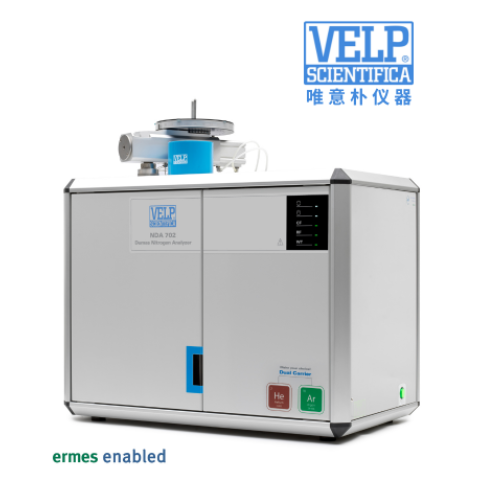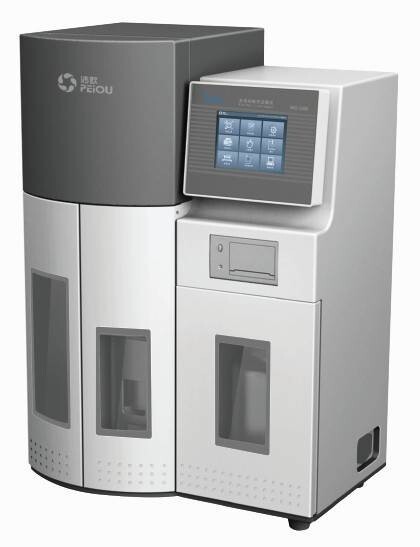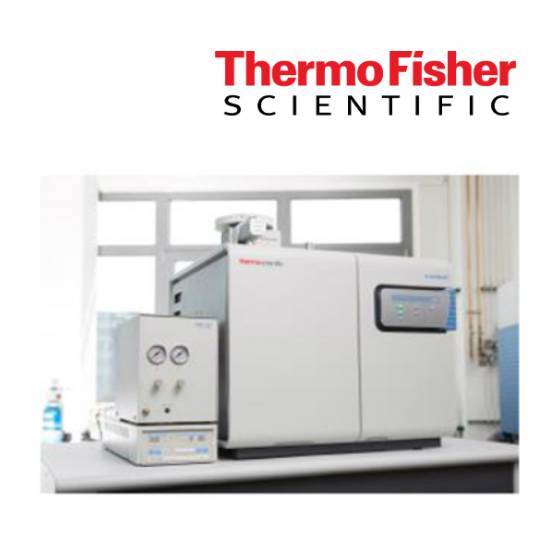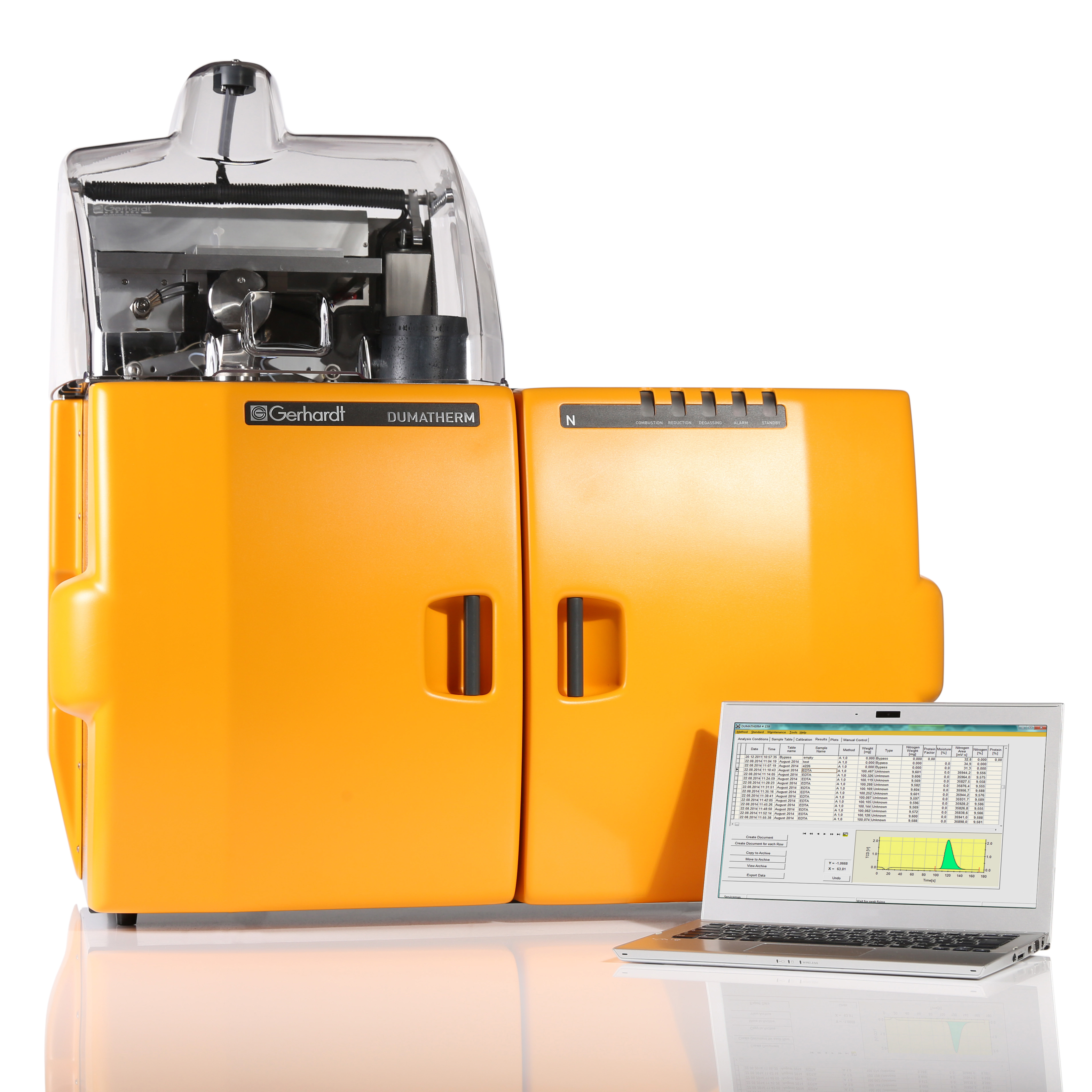
方案详情
文
葡萄籽提取物粉对咸酸奶饮料总酚含量和抗氧化性能的影响Effect of grape (Vitis vinifera L. cv. Dimrit) seed extract powder on total phenolic content and antioxidant properties of ayran drink
总氮含量使用格哈特公司的杜马森Dumatherm全自动杜马斯法定氮仪检测,使用6.38的蛋白质转换系数计算酸奶饮料中的蛋白质含量。
Total nitrogen content by Dumas method using the Dumatherm® analyzer. A conversion factor of 6.38 was used to calculate the protein content of drinks.
方案详情

葡萄籽提取物粉对咸酸奶饮料总酚含量和抗氧化性能的影响 Effect of grape (Vitis vinifera L. cv. Dimrit) seed extract powder on total phenolic content and antioxidant properties of ayran drink总氮含量使用格哈特公司的杜马森Dumatherm全自动杜马斯法定氮仪检测,使用6.38的蛋白质转换系数计算酸奶饮料中的蛋白质含量。Total nitrogen content by Dumas method using the Dumatherm® analyzer. A conversion factor of 6.38 was used to calculate the protein content of drinks.SsciendoDOI: 10.2478/auoc-2022-0021Ovidius University Annals of ChemistryVolume 33, Number 2, pp. 143 -149, 2022 Gursoy et al./Ovidius University Annals of Chemistry 33 (2022)143-149 葡萄籽提取物粉对咸酸奶饮料总酚含量和抗氧化性能的影响 Effect of grape (Vitis vinifera L. cv. Dimrit) seed extract powder on totalphenolic content and antioxidant properties of ayran drink Rabia FAKI, Kubra KOCATURK,' Oguz GURSOY*, and Yusuf YILMAZ2 ayran drink艾兰饮料:一种土耳其咸酸奶饮料 Burdur Mehmet Akif Ersoy University, Institute of Natural and Applied Sciences, Division ofFood Engineering, Burdur, Turkey 2Burdur Mehmet AkifErsoy University, Faculty ofEngineering and Architecture, Department of Food Engineering,Burdur, Turkey Abstract. In this study, the lyophilized extracts of grape (Vitis vinifera L. cv. Dimrit) seeds [0 (control), 4, 5 and 6 mg/100mL)] were incorporated into ayran drinks, and the total solids, fat, pH, acidity (% lactic acid) and CIELAB color values,total phenolic content, antioxidant activity values, some microbiological and sensory properties of ayran drinks weredetermined during storage at 4±1 °C for 10 days. The addition of grape seed extract powder (GSEP) had an insignificanteffect on the pH, acidity and L* values of ayran drinks (p>0.05), but the a* and b* color values of drinks increased asits concentration increased. The incorporation of GSEP into ayran drinks increased the total phenolic content andantioxidant activity values of samples significantly in comparison to control samples (p <0.05). Addition of GSEP toayran drinks did not change the counts of lactobacilli and lactococci in ayran drinks during storage. Panelists in sensoryevaluation liked the flavor and color properties of control and ayran drinks with 4 mg/100 mL GSEP more than othersamples (p<0.05). Results indicated that GSEP might have a great potential to increase the antioxidant activity of ayrandrinks, but its concentration is primarily limited by its bitter taste in drinks. Keywords: antioxidant activity; ayran; grape seed; phenolic content. 1. Introduction Acidified milk drinks are popular worldwide and havemany health benefits and high nutritional value. Ayran(or yogurt drink) is an acidified milk drink produced bydiluting and homogenizing yogurt with water or thefermentation of standardized milk with starter culturesStreptococcusthermophilusaand Lactobacillusdelbrueckii subsp. bulgaricus) [1, 2]. Plain yogurt drinkssuch as doogh, lassi, chaas and ayran are popular in awide geographical region from Central Asia to theBalkans, including Anatolia and the Middle East whilein Europe and the US, yogurt drinks with fruits andsweeteners are preferred mostly [2]. It is reported thatthe consumption of ayran per capita in Turkey in 2019is 18.1 kg [3]. Grapes, one of the most common cultivated plants inthe world [4], are cultivated all over the world with thetotal area under vines reaching, in 2019, 7.4 millionhectares with Spain (13.1%), China (11.5%), France(10.7%), Italy (9.6%) and Turkey (5.9%) representingmore than 50% of the world's vineyard [5]. Grapes areeasy to cultivate because their climatic and soilrequirements are not very selective, and their fruits canbe consumed in a variety of ways [6]. Grape berriesgenerally consist of skin, pulp and seed parts and 80-90% of berry weight is juice. The number of seeds in thegrain varies between 0-4 [7]. Production of fruit juice,wine and molasses produces grape seeds as a by-product, which are rich in phenolic compounds withantioxidant properties. Gallic acid. catechin. epicatechin, and dimeric, trimeric, oligomeric orpolymeric procyanidins are major phenolic constituentsof grape seeds [8]. Therefore, grape seeds are valuablefor human health and have been used as a foodsupplement and a source of natural antioxidants [9]. Ithas been stated that the proanthocyadins contained ingrape seed extract, which is a natural antioxidant source,are 50 times stronger than vitamin C and 20 timesstronger than vitamin E [10]. Grape seed production isestimated as approximately 30 thousand tons per year inTurkey [11]. Grape seed oil consumption may increaseHDL cholesterol level while reducing LDL level [12].The oil yield, bioactive components and aroma profilesof grape seeds also differ according to grape genotype[13]. Grape seed extract is known as a powerfulantioxidant source that may protect human body againstcertain diseases like Alzheimer and cancer [14]. In a number of studies, grape seed powder extractswere added into biscuits, yogurt, ice cream, vegetableoils, red and white meat products as a natural antioxidantsource [15-23]. In addition, there are some studies [24-27] on the use of grape seed extract to increase theantioxidant activity of yogurt while there is a lack ofstudy on increasing the antioxidant activity of ayrandrink by its incorporation. In this study, our aim was toincrease the total phenolic content (PC) and antioxidantactivity value of ayran drink by adding different ratiosof GSEP into drinks. The effect of GSEP addition onsome physico-chemical properties (dry matter, pH,acidity and color values) of ayran drinks were "Corresponding author. E-mail address: ogursoy@mehmetakif.edu.tr (Oguz Gursoy) determined during storage at 4±1 C for 10 days inaddition to their microbiological and sensory properties. 2. Experimental 2.1. Materials Fresh grapes of Vitis vinifera L. cultivar Dimrit wereobtained from a local producer in Burdur (Turkey).Trolox@ [(±)-6-hydroxy-2,5,7,8-tetramethylchromane-2-carboxylic acid] and gallic acid [(HO)3C6H2CO2H]obtained from Fluka (St. Louis, MO, USA) andpotassium persulfate (K2S2Os), Folin-Ciocalteu reagent,chromatographic grade ethanol (CH;CH2OH), bufferedpeptone water, MRS and M17 agars obtained fromMerck (Darmstadt, Germany) were used in analyses.Chromatographic grade methanol (CH;OH) and ABTS[2.2'-azino-bis (3-ethylbenzothiazoline-6-sulfonate)]were purchased from Sigma-Aldrich (St. Louis, MO,USA) and sodium carbonate (Na2CO3) from Riedel-deHaen (Charlotte, NC,USA). 2.2. Methods 2.2.1. Preparation of grape seed extract powder Grape seed ethanolic extract was prepared with slight modifications as described by Yilmaz and Toledo [8].After seeds were carefully separated from fresh berries,drying at 40 ℃ for 24 h was performed in a convectiveoven (Wisecube, Daihan, Korea). Seeds were ground bya grinder, and a sieve was used to standardize theparticle size of ground seed powder. After grape seedpowder and aqueous ethanol (70% by volume) (1:10,w/v) were mixed and sonicated for 10 min in a waterbath, this mixture was shaken for 15 min on an orbitalshaker at 200 rpm. Following the centrifugation ofsamples in Falcon@ tubes at 8000 rpm for 10 min at10°C, clear supernatantswere separated, and thisprocedureWasapplied again ffor solid residues.Supernatants in amber bottles were stored at -24°C. Byusing2a rotary evaporator, ethanolic phaseswereevaporated at 40℃ under vacuum, and remaining(aqueous) phase was dried in a freeze-drier to obtainfreeze-dried extract powder. 2.2.2. Ayran production and addition of grape seedextract powder into ayran Plain yoghurt with different production dates from alocal dairy plant (BurSut, Organized Industrial Zone,Burdur, Turkey) was used for the production of ayrandrinks. For this purpose, plain yogurt was diluted bydrinking water (3:1, w/v) and mixed with table salt at aratio of 0.70%. This mixture was mixed with a standmixer (Arzum AR1069 Cust Mix Stand Mixer, Istanbul,Turkey) using its whisker unit at a mixing level of 4 for3 min to produce ayran samples. This bulk ayran drinkwas divided into four equal volumes including control.Preliminary experiments showed that a bitter taste washighly noticeable in ayran drinks when more than 6 mgof GSEP was added into 100 mL of ayran. Therefore,GSEP concentrations added to 100 mL of ayran drinkswere adjusted to be 4, 5 and 6 mg. The stand mixer wasused to produce a homogenous ayran drinks with GSEP.Control and GSEP added samples were stored in Schottbottles (0.5 L) with caps screwed at 4℃ for 10 days. 2.2.3. Physicochemical analysis The total solid content of ayran drinks was determinedby the method of ISO/IDF [28], fat content by Gerbermethod [29] and total nitrogen content [30] by Dumasmethod using the Dumatherm@ analyzer. A conversionfactor of 6.38 was used to calculate the protein contentof drinksS..TThe pH values of ayran drinksweredetermined by a pH meter. Titratable acidity values weredetermined on the 1st, 5th and 10th days of storageaccording to Oysun [29]. The CIE (Commission International de L'Eclairage)L*, a* and b* color values of ayran drinks weredetermined on the 1st, 5th and 10h days of storage usinga colorimeter (Model CR-400, Konica Minolta, Japan).Color readingswereeperformedusingtheD65illuminator, 10° observer angle and 8 mm diameterdiaphragm. Measurements were conducted at roomtemperature, using a 5 mL sample in an optical glass cellprovided by the manufacturer of colorimeter, and takingthe averages of 4 measurements at 3 second intervals.For L* (luminance value) color values, 0 and 100indicate black and white color, respectively. Whilepositive a* and b* color values indicate red and yellow,negative a* and b* color values indicate green and blue,respectively. 2.2.4. Antioxidant activity assay ABTS assay according to Thaipong et al. [31] was usedto determine the antioxidant activity of extracts andayran drinks on the 1s and 10" days of storage. ABTSdissolved in distilled water was mixed with 2.6 mMK2S2O:(1:1,v/v). This mixture was kept in dark for 12-16 hours at room temperature for the formation of ABTSradicals. ABTS working solution was prepared bydiluting this solution with CH;OH so that the finaal1absorbanceWas 1.20±0.022inn cuvettes. AffreshcalibrationCcurveof TroloxR Waspreparedfforquantification on the day of each experiment. Theregression equation was y = - 0.0311 (±0.0054)x+1.0119 (±0.0397), where y is absorbance value and x isthe concentration of Trolox@ solution) with R≥0.986.Sample or standard (150 pL) and ABTS workingsolution (2850 pL) were mixed in a test tube andallowed to react for 30 min in dark. Then, the absorbanceof colored solutions was obtained at 734 nm by using aspectrophotometer (Optizen POP, Mecasys, Daejeon,Korea), and antioxidant activity values were calculatedas umol Trolox@ equivalent (TE) per 100 mL ayrandrinks and expressed as mean ± standard deviation. 2.2.5. Total phenolic content The total phenolic contents of ayran drinks and extractswere determined by the micro-adapted Folin-Ciocalteu(FC) method [32]. The FC reagent was diluted withdistilledlwater at a rate of 1:10(v/v), and theconcentration of Na2COs solution was 20% (w/v). Thefresh stock solution of gallic acid (500 mg/L) was usedto obtain a calibration curve on the day of eachexperiment, where a linear region was between 5 and100 mg/L. The regression equation was y = -0.0094(±0.0006)x+0.0233 (±0.0027), where y is absorbancevalue and x is the concentration of gallic acid solution)with R2≥0.999. Sample or standard (2 mL) and diluteFC reagent (10 mL) were first mixed, and then NazCO3 solution (8 mL, 20% w/v) was added in 1-8 minutes, andthe reaction was allowed to continue for 2 h in dark.Finally, the absorbance values of colored solutions wereobtainedby a spectrophotometer (Optizen POP,Mecasys, Daejeon, Korea) at 760 nm, and total phenoliccontents were calculated as mg gallic acid equivalent(GAE) per 100 mL ayran drinks and expressed as mean土 standard deviation. The total phenolic contents ofayran samples were determined on the 1st and 10h daysof storage at 4°C. 2.2.6. Microbiological analysis Ayran drinks were aseptically sampled, and bacterialcounts were carried out on the 5th and 10th days ofstorage. Buffered peptone water was used to dilutesamples (10 mL). The enumeration was carried outusing the pour plate technique described by Da Silva etal. [26]. The enumeration of Lactobacillus spp. wasobtained on MRS agar, following 48 h incubation at37±1°C under anaerobic conditions while Lactococcusspp. was enumerated on M17 agar, following 48 hincubation at 37±1°C under aerobic conditions. 2.2.7. Sensory analysis Ranking test was used in sensorial flavor and colorevaluations of ayran drinks according to Bodyfelt et al.[33]. Panelists included staff and students of theDepartment of Food Engineering in Burdur MehmetAkif Ersoy University (Burdur, Turkey). A different 3-digit numeric code was randomly assigned to each ayrandrink. Samples in white plastic cups were served topanelists in varying orders by using individual boothsequipped with daylight. Panelists ranked ayran samplesfrom ‘the most liked’to ‘the least liked’ by the flavorand color of samples. Panelists were allowed to drinkwater to cleanse their palate between samples. 2.2.8. Statistical analysis All experiments were duplicated while all analyses werecarried out in two parallels. The analysis of variance(ANOVA) was conducted to determine the effect ofGSEP concentration and storagetime on thephysicochemical properties,,aantioxidant activity,phenolicCcontent,microbiological and sensoryproperties of ayran drinks by using Statistical AnalysisSystem (SAS) version 9.0 (SAS Institute Cary, NC,USA). Differences between means were tested by theDuncan multiple comparison test at a p<0.05 level. 3. Results and discussion 3.1. Physico-chemical properties The total solids, fat and protein content of the controldrinks on the 1 day of storage were determined as9.79±0.04,2.55±0.06 and 2.65±0.34%, respectively.The pH and acidity values of ayran drinks during storageare given in Table 1. The addition of GSEP to ayrandrinks and storage time had a statistically insignificanteffect on the pH values of drinks (p >0.05). Da Silva etal. [26] reported that the addition of grape extract (1.5and 3.0 g/L) into yoghurt did not influence the pH,titratable acidity (%), protein, ash, fat and moisturecontents of yoghurt samples. However, Brahmi et al.[23] and Demirbiiker Kavak and Akdeniz [27] reportedthat the addition of grape seed extract to yogurt slightly decreased the pH values of the yogurt samples. In ourstudy, pH values of drinks were compatible with thosereported in plain ayran drinks by Tonguc [34] andGursoy et al. [35]. Acidity values (%) of samples variedbetween 0.48±0.02 and 0.54±0.04 during storage, whichwere in good agreement with previous studies [35,36].Acidity values of all samples on the 1st, 5th and 10th daysof storage (0.48,0.512andd0.53%, respectively)increased during storage (p <0.05) (Table 1), andinteraction between storagetime anddGSEPconcentration was statistically insignificant (p>0.05). Table 1. pH and acidity values (%) of ayran drinks withgrape seed extract powder (GSEP) at different concentrationsduring 10 days of storage (n=2) (mean ± standarddeviation). GSEPconcen-tration inayran drinks(mg/100 mL) pH Acidity (Lactic acid,%) Storage days Storage days 1 5 10 1 5 10 0 4.16±0.04 4.14±0.02 4.20±0.30 0.48±0.02 0.51±0.01 0.53±0.06 4 4.17±0.02 4.11±0.02 4.25±0.24 0.49±0.02 0.51±0.01 0.53±0.04 5 4.19±0.02 4.12±0.03 4.27±0.23 0.48±0.02 0.50±0.01 0.53±0.03 6 4.19±0.02 4.16±0.07 4.28±0.21 0.48±0.02 0.52±0.02 0.54±0.04 Color is an important factor of yogurt-like fermentedproducts, influencing consumer’s acceptability of aproduct [37]. A high L* color value is an importantquality parameter for ayran drink [35]. Storage timeinfluenced the L* and b* color values of ayran drinkssignificantly (p<0.05) (Figure 1). Figure 1. Changes in CIE L*(a) and b* (b) color values ofayran drinks during 10 days of storage (Different superscriptsin each figure show statistical significances (p <0.05). Significant differences in a* and b* values werefound among ayran drinks containing different amountsof GSEP (p > 0.05) (Figure 2). Demirkol and Tarakei[38] reported that adding freeze- and oven-dried grapepomace samples to yogurt at different rates (1, 3 and5%) decreased the L* and b* color values of samples while increased a* color values. Similarly, the additionof 3% organic Bordeaux grape (Vitis labrusca L.) seedflour into yogurt was reported0y to decrease the L* valuesof yogurt samples while increasing their a* and b*values by da Rocha Zanetti et al. [39]. In our study, anincrease in the concentration of GSEP added to ayrandrinks decreased L* color values and increased a* colorvalues, which was similar to results reported byDemirkol and Tarakci [38] and da Rocha Zanetti et al.[39]. The differences in b* values of samples reportedin the literature could be due to variations in GSEPconcentrations and grape variety used as a source ofseeds. -2.30 -2.55 -2.63A -2.80 -3.05 5.00 4.75 4.69A 4.50 425 b. Figure 2. Changes in CIE a* (a) and b* (b) color valuesdepending on the concentration of grape seed extract powdermg/100 mL grape seed extract powder added ayran drink(Different superscripts in each figure show statisticalsignificances (p <0.05). 3.2. Total phenolic content and antioxidant activity Phenolic compounds are significant constituents of plantfoods, and they influence the sensory properties of foodssuch as flavor, color and astringency directly. Inaddition, the presence of phenolic compounds in humandiet have some beneficial effects to health because oftheir chemo-preventive activities against carcinogenesisand mutagenesis, which are mainly associated with theirantioxidant activities [40]. The antioxidant activity (byDPPH assay) and total phenolic contents of GSEP weredetermined as 6,224 umol TE/g dry matter and 66,909mg GAE/g dry matter, respectively. Total PC andantioxidant values of ayran drinks during 10 days ofstorage are presented in Table 2. The addition of GSEPto ayran drinks significantly influenced the total PC andantioxidant activity values of samples (p<0.05). The total phenolic contents and antioxidant activity values ofayran drinks with GSEP were higher than those ofcontrol samples (Figure 3). Increased antioxidantactivity via the fortification of samples with GSEP wasin good agreement with previous reports [25,27].Similarly, Altin [41] reported that the addition of cocoashell (1:10 v/v) encapsulated by different methods toayran drinks increased the total PC and antioxidantactivity of samples. In a study by Unal et al. [42], it wasreported that the addition of green tea and black teaextracts at two different rates (2 and 4%) in theproduction of ayran drinks increased the total PC andantioxidant activity of ayran samples. Individual effectof storage time on total PC of samples was statisticallysignificant (p<0.05). Total phenolic contents of drinksincreased during storage (Figure 4). GSEP concentrationand storage time interaction had an insignificantinfluence on the total PC and antioxidant values of ayrandrinks (p>0.05). storage (n=2) (mean ± standard deviation). Table 2. Changes in total phenolic content and antioxidantactivities of ayran drinks with grape seed extract powder(GSEP) at different concentrations on the 1st and 10th days of GSEPconcentrationin ayrandrinks Phenolic content(mg GAE/100 mL) Antioxidant value(umol TE/ 100 mL) Storage time (Day) Storage time (Day) 1 10 1 10 0 6.31±0.30 6.75±0.14 1.40±0.12 1.34±0.07 4 6.46±0.34 7.36±0.34 1.48±0.15 1.39±0.04 5 6.50±0.22 7.34±0.15 1.49±0.14 1.44±0.05 6 6.69±0.28 7.34±0.42 1.50±0.13 1.47±0.05 8.501 88.00 三77.50 7.00 7.02A 650 SHouaydpupo 6.00 5.50 5.00 1.80- 1.70 1.60 311.50 1.49A 三11.40 1.30 1.20 1.10 100 b. Figure 3. Effect of grape seed extract powder on totalphenolic contents (A) and antioxidant activities (B) of ayrandrinks (Different superscripts show statistical significances atp<0.05). Figure 4. Changes in total phenolic contents of ayran drinksafter 10 days of storage at 4℃ (Different superscripts showstatistical significances at p<0.05). 3.3. Microbiological properties Some of lactic acid bacteria (LAB) species may grow inplant-derived food substrates, which can be rich inphenolic compounds, and most of these compounds mayinhibit LAB growth [40]. However, antimicrobial effect1Srelated to different factors such1astype andconcentration of phenolic compound present in themedium, type and strain of bacteria [40]. Lactobacillusspp. count of the control ayran drinks on the 1st day ofstorage Was 6.52±0.01 log cfu/mLwhilee theLactococcus spp. count was 7.75±0.73 log cfu/mL. Itwas determined that the concentration of GSEP in ayrandrinks did not influence the lactobacilli and lactococcicounts on the 5th and 10h days of storage (Figure 5). Inthe literature, it was reported that grape pomace additionhad no effect on the lactobacilli and lactococci counts ofyogurt during 21 days of storage [38]. Similarly, Cossuet al. [43] reported that the chemical and microbiologicalcharacteristics of yogurts might not be influenced by theincorporation of selected edible polyphenolic extracts. Figure 5. Changes in Lactobacillus spp.(A) and Lactococcusspp. (B) counts of ayran drinks containing grape seed powderextract at different concentrations on the 5th and 10th days ofstorage. 3.4. Sensory properties The addition of GSEP into ayran drinks significantlyinfluenced their sensory flavor and color scores (p<0.05) (Figure 6). The flavor and color scores of thecontrol and ayran drinks with 4 mg/100 mL GSEP werefound statistically similar (p> 0.05). Similarly,differences in the flavor and color scores of ayransamples with5 and 66 mg/100 mL GSEP wereinsignificant (p>0.05). Panelists liked control and ayransamples with 4 mg/100 mL GSEP more than others (p< 0.05). Previously, it was reported that the addition ofgrape seed extract (121.80-224.53 mg GAE/g) tostrained yogurt might adversely influence the sensoryflavor scores of yogurt [24]. Demirbuker Kavak andAkdeniz [27] reported that high amounts of grape seedextract addition (>0.15 g/100 g) to yogurt samples werenot appreciated by panelists from sensorial point ofview. Our results were in good agreement with thosefindings. Figure 6. Ranking scores of sensory flavor and color forayran drinks containing grape seed powder extract atdifferent concentrations (Different letters show statisticalsignificances at p<0.05). 4. Conclusions The addition of GSEP did notinfluence somephysicochemical properties (pH, acidity and L* colorvalues) and microbiological properties of ayran drinks(p >0.05); however, a* and b* color values of samplesincreased as its concentration in ayran drinks increased.In terms of flavor and color, control and ayran sampleswith 4 mg/100 mL GSEP were liked more by thepanelists than other samples (p <0.05). It wasdemonstrated that GSEP could be successfully used toincrease the antioxidant activity of ayran drinks. On theother hand, high concentrations of GSEP may influencethe sensory flavor and color properties of ayran drinks(>4 mg/100 mL) adversely. Therefore, ayran drinkcould be used as a carrier for phenolic compounds ofGSEP, and concentrations lower than 5 mg/100 mLsample are highly recommended to minimize anyadverse effect on the sensorial properties of drinks. Conflict of interest Authors declare no conflict of interest. References [1]. A.D.P. Thi, R. Ipsen, Stabilization of acidifiedmilk drinks using pectin, Asian Journal of Foodand Agro-Industry 2 (2009) 155-165. [2].H. Colakoglu, O. Gursoy, Effect of lactic adjunctcultures on conjugated linoleic acid (CLA)concentration of yogurt drink, Journal of FoodAgriculture and Environment 9 (2011)60-64. [31.1National Dairy Council, National Dairy CouncilMilk Report 2020, Dairy Sector Statistics inandTurkeythe World.https://ulusalsutkonseyi.org.tr/ulusal-sut-konseyi-sut-raporu-2020-3639/,2020. [4]. Y. Akova, Raisins, Republic of Turkey, PrimeMinistry Undersecretariat of Foreign Trade, ExportPromotion Center Sector Report (in1Turkish)Ankara, 2009. [5].OIV, State of the world vitivinicultural sector in2019, International Organization of Vine andWine, (2020).https://www.oiv.int/public/medias/7298/oiv-state-of-the-vitivinicultural-sector-in-2019.pdf,Accessed 4th August 2022. [6].V. Georgiev, A. Ananga, V. Tsolova, Recentadvancesand1usesofgrape flavonoids asnutraceuticals, Nutrients 6 (2014) 391-415. Doi:10.3390/nu6010391 [7].NM. Otag, Determination of some properties andresveratrol content of some grape varieties grownin Denizli Cal region during different ripeningperiod and after drying process. Ph.D. Thesis,Pamukkale University, Denizli, Turkey, 2015. [8].】Y. Yilmaz,R.T. Toledo, Major flavonoids in grapeseeds and skins: antioxidant capacity of catechin,epicatechin, and gallic acid, Journal of Agriculturaland Food Chemistry 52 (2004) 255-260. Doi:10.1021/jf030117h [9].JJ.L. Marques, G.D. Porta, E. Reverchon, J.A.R.Renuncio, A.M. Mainar, Supercritical antisolventextraction of antioxidants from grape seeds aftervinification, The Journal of Supercritical Fluids 82(2013) 238-243. Doi:10.1016/j.supflu.2013.07.005 [10].J. Shi, J. Yu,J.E. Pohorly,Y.Kakuda,Polyphenolics in grape seeds-biochemistry andfunctionality, Journal of Medicinal Food 6 (2004)291-299. Doi: 10.1089/109662003772519831 [11]. S. Gok Tangolar, Y. Ozogul, S. Tangolar, A.Torun, Evaluation of fatty acid profiles andmineral content of grape seed oil of some grapegenotypes, International Journal of Food Sciencesand Nutrition 60 (2009) 32-39. Doi:10.1080/09637480701581551 [12]. A. Akin, A. Altindisli, Determination of fatty acidcomposition and total phenolic contents of grapeseed oils of Emir, Gok Grape and Kara Dimritvarieties, Akademik Gida 8 (2010)19-23. [13]. L. Fernandes, S. Casal, R. Cruz, J.A. Pereira, E.Ramalhosa, Seed oils of ten traditional Portuguesegrape varieties with interesting chemical andantioxidant properties, Food ResearchInternational 50 (2013) 161-166. Doi:10.1016/j.foodres.2012.09.039 [14]. L. Ho, S. Yemul, J. Wang, G.M. Pasinetti, Grapeseed polyphenolic extract as a potential noveltherapeutic agenttin tauopathies, JournalofAlzheimer's Disease 166(2009) 433-439. Doi:10.3233/JAD-2009-0969 [15]. Tseng, Y. Zhao, Wine grape pomace as antioxidantdietary fibre for enhancing nutritional value andimproving storability of yogurt and salad dressing,Food Chemistry1388(2013)356-365.IDoi:10.1016/j.foodchem.2012.09.148 [16].R. Marchiani, M. Bertolino, S. Belviso, M.Giordano, D. Ghirardello, L. Torri, M. Piochi,G.Zeppa, Yogurt enrichment with grape pomace: effect of grape cultivar onnphysicochemical,microbiological and sensory properties, Journal ofFood Quality (2016) 1745-4557. Doi:10.1111/jfq.12181 [17].D. Bandonien, A. Pukalskas, P.R. Venskutonis, D.Gruzdien, Preliminary screening of antioxidantactivity of some plant extracts in rapeseed oil, FoodResearch International 33 (2000) 785-791. Doi:10.1016/S0963-9969(00)00084-3 [18].V. Reddy, A. Urooj, A. Kumar, Evaluation ofantioxidant activity of some plant extracts and theirapplication in biscuits, Food Chemistry 90 (2005)317-321. Doi: 10.1016/j.foodchem.2004.05.038 [19]. J. Martinez, G. Nieto, J. Castillo, G. Ros, Influenceof in vitro gastrointestinal digestion and/or grapeseed extract addition on antioxidant capacity ofmeat emulsions, Food Science and Technology 59(2014)834-840.Doi: 10.1016/j.lwt.2014.07.048 [20]. A.C.S. Barretto, E.I. Ida, R.S.F. Silva, E.A.F.S.Torres, M. Shimokornaki, Empirical models fordescribing poultry meat lipid oxidation inhibitionbynaturalantioxidants.,Journal0of FoodComposition and Analysis 16 (2003)587-594.Doi: 10.1016/S0889-1575(03)00023-1 [21]. J. Libera, A. Latoch, K.M. Wojciak, Utilization ofgrape seed extract as a natural antioxidant in thetechnology of meat products inoculated with aprobiotic strain of LAB, Foods,9(2020) 103.https://doi.org/10.3390/foods9010103 [22].S. Akca, A. Akpinar, The effects of grape,pomegranate, sesame seed powder and their oils onprobiotic ice cream: ttotal phenolic contents,antioxidant activity and probiotic viability, FoodBioscience, 42 (2021) 101203 [23].F. Brahmi,F. Merchiche, S. Mokhtari, L. Smail, H.Ghemghar, D. Yalaoui-Guellal, S. Achat, M.F.Elsebai, K. Madani, L. Boulekbache, Optimizationof some extraction parameters of phenolic contentfrom apple peels and grape seeds and enrichmentof yogurt by their powders: a comparative study,Journal of Food Processing and Preservation 45(2021) e15126. Doi: 10.1111/jfpp.15126 [24]. E. Ersoz, O. Kinik, O. Yerlikaya, M. Acu, Effectof phenolic compoundsoncharacteristics ofstrained yoghurts produced from sheep milk,African Journal of Agricultural Research 6 (2011)5351-5359. Doi: 10.5897/AJAR11.1012 [25].V. Chouchouli,N. Kalogeropoulos, S.J. Konteles,E. Karvela, D.P. Makris,V.T. Karathanos.Fortification of yoghurts with grape (Vitis vinifera)seed1extracts,LWTT-一FFoodScience andTechnologyy (2013) 522-529. Doi:10.1016/j.lwt.2013.03.008 [26].D.F. Da Silva,N.N.T. Junior,R.G. Gomes, M.S.S.Pozza,1M. Britten.PP.T. Matumoto-Pintro.Physical, microbiological and rheologicalproperties of probiotic yogurt supplemented withgrape extract,Journal1FoodScience and54Technology(2017) 1608-1615. Doi:10.1007/s13197-017-2592-X [27].D. Demirbiiker Kavak, B. Akdeniz,Physicochemical characteristics and antioxidantcapacity of traditional yogurt fortified with grape (Vitis vinifera L.) seed extract at different levels,Kocatepe Veterinary Journal 12 (2019)389-395.Doi: 10.30607/kvj.596784 [28].ISO/IDF, ISO6731-IDF21, Milk, creamandevaporated milk-determination of total solidscontent (Reference method), Brussels, 2010. [29].G. Oysun, Analysis methods in milk and milkproducts, Ege University Faculty of AgriculturePublications No: 504, Bornova, izmir, Turkey,2001. [30].F. Shea, C.E. Watts, Dumas method for organicnitrogen, Industrial &Engineering ChemistryAnalytical Edition 11 (1939) 333-334. [31].K. Thaipong, U. Boonprakob, K. Crosby, L.C.Zevallos, D.H. Byrne, Comparison of ABTS,DPPH, FRAP and ORAC assays for estimatingantioxidant activity from guava fruit extracts,Journal of Food Composition and Analysis 19(2006) 669-675. Doi: 10.1016/j.jfca.2006.01.003 [32]. V.L. Singleton, J.A. Rossi, Colorimetry of totalphenolics with phosphomolybdicphosphotungsticacid reagents, American Journal of Enology andViticulture 16 (1965) 144-158. [33]. F.W. Bodyfelt, J. Tobias, G.M. Trout, The sensoryevaluationof dairy products. Van NostrveReinhold, New York, USA, 1988. [34]. I.E. Tonguc, A research on probiotic yoghurt drinkproduction, MSc Thesis, Ege University, Izmir,Turkey, 2006. [35].O. Gursoy, Y. Yilmaz, O. Gokce, K. Ertan, Effectof ultrasound power on physicochemical andrheological properties of yoghurt drink producedwith thermosonicated milk, Emirates Journal ofFood and Agriculture 28 (2016) 235-241. Doi:10.9755/ejfa.2015-09-719 [36].B. Tamucay-Ozunlu, C. Kocak, Effect of endingthe incubation at different pHs on quality of ayran,Gida 35 (2010)113-119. [37]. I. Scibisz, M. Ziarno, M. Mitek, Color stability offruit yogurt during storage, Journal of FoodScience and Technology 56 (2019) 1997-2009.Doi: 10.1007/s13197-019-03668-y [38].M. Demirkol, Z. Tarakci, Effect of grape (Vitislabrusca L.) pomace dried by different methods onphysicochemical, microbiological and bioactiveproperties of yoghurt, LWT -Food Science andTechnology97 (2018) 770-777. Doi:10.1016/j.lwt.2018.07.058 [39].M.B. da Rocha Zanetti, I.C. da Silva Haas, M.Pereira-Coelho, B.M. Maran, M.H.M. Canella,L.A. dos Santos Madureira, E.S. Prudencio, R.D.de Mello Castanho Amboni, D.C. da SilvaKazama,M.M.C. Feltes, Valorization of biowastesfrom sustainable viticulturewith bioactivepotential: application in functional yogurt, Journalof Food Science and Technology (2022). Doi:10.1007/s13197-022-05547-5 [40]. H. Rodriguez, J.A. Curiel, J.M. Landete, B. de lasRivas, F.L. de Felipe, C. Gomez-Cordoves, R.Mufioz, Food phenolics and lactic acid bacteria,International Journal of Food Microbiology 132(2009) 79-90. Doi:10.1016/j.ijfoodmicro.2009.03.025 [41]. G. Altin, Fortification of ayran (drinking yoghurt)with encapsulated cocoa hull waste extract bynanoliposomal systems, shelf life andbioaccessibility studies, MSc Thesis, IstanbulTechnical University, Istanbul, Turkey, 2016. [42]. G. Unal, C. Karagozlii, O. Kinik, E. Akan, A.S.Akalin, Influence of supplementation with greenand black tea onviscosityandsensorycharacteristics of drinkingyoghurt, EgeUniversitesi Ziraat Fakiiltesi Dergisi 53 (2016)343-349. [43].M. Cossu, C.C.A. Juliano, R. Pisu, M.C.P.Alamanni. Effects of6enrichment withpolyphenolic extracts from Sardinian plants onphysico-chemical, antioxidant and microbiologicalproperties of yogurt, Italian Journal of FoodScience 21 (2009)447-459. Received: 17.05.2022 Received in revised form: 09.09.2022
确定
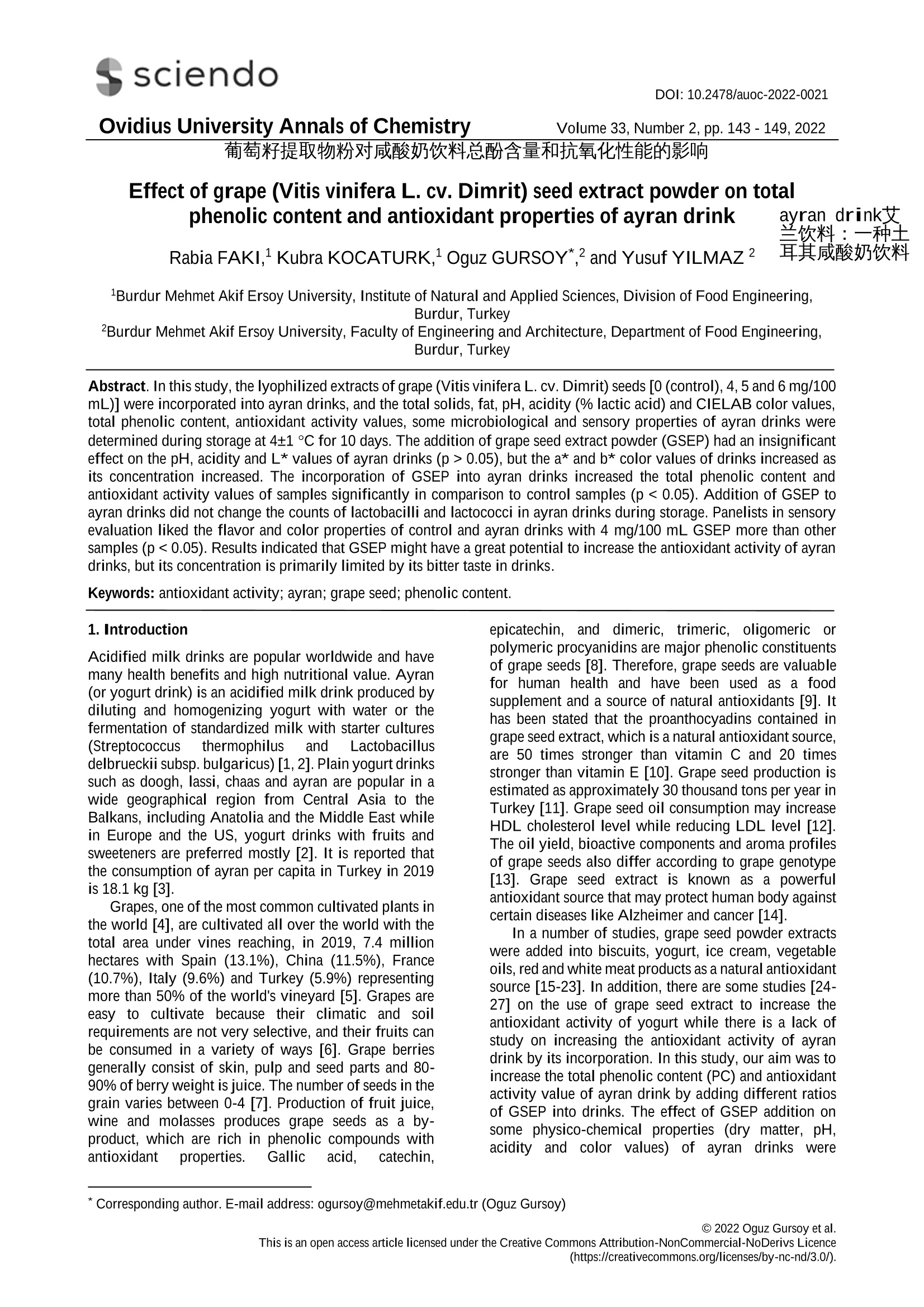
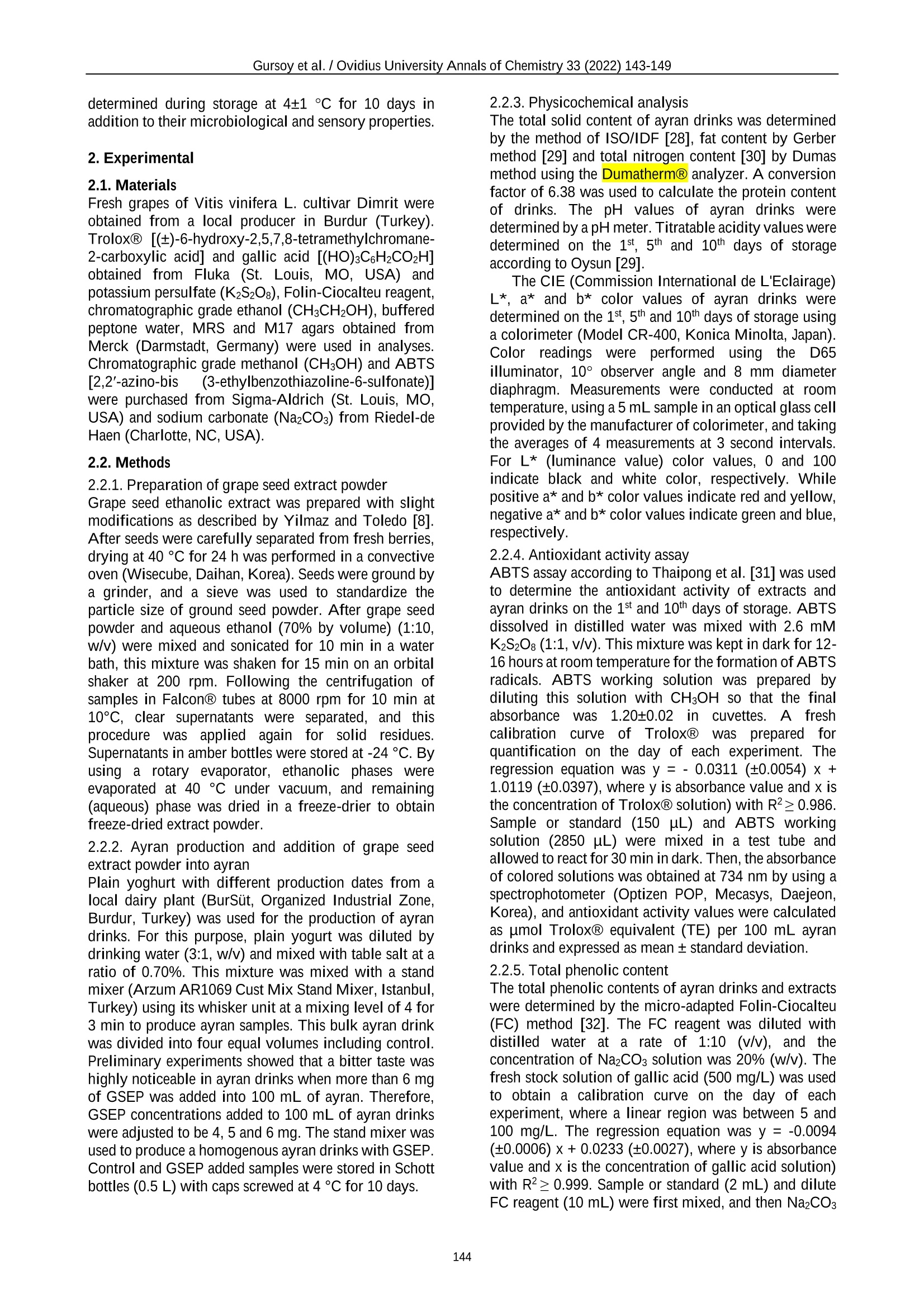
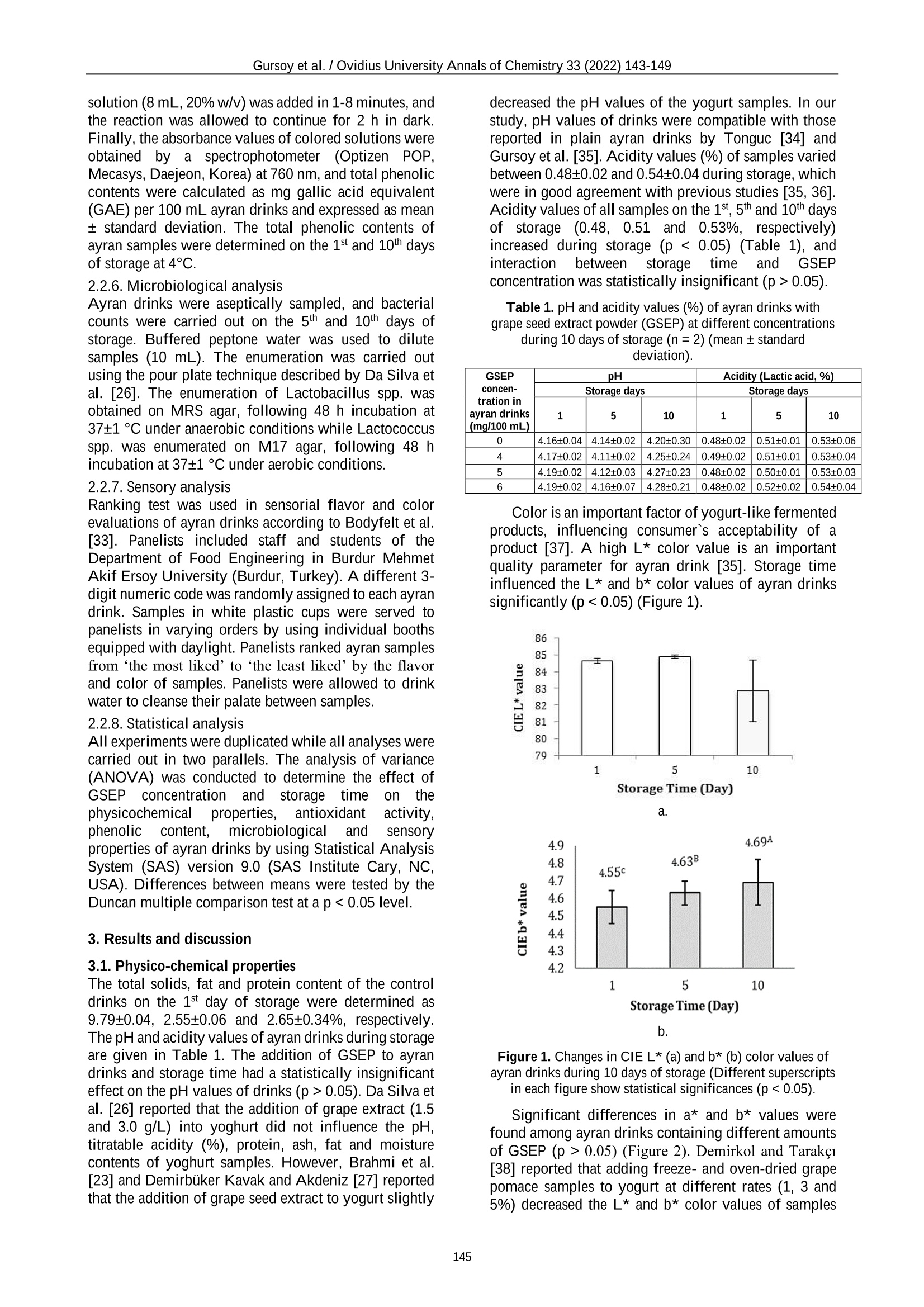
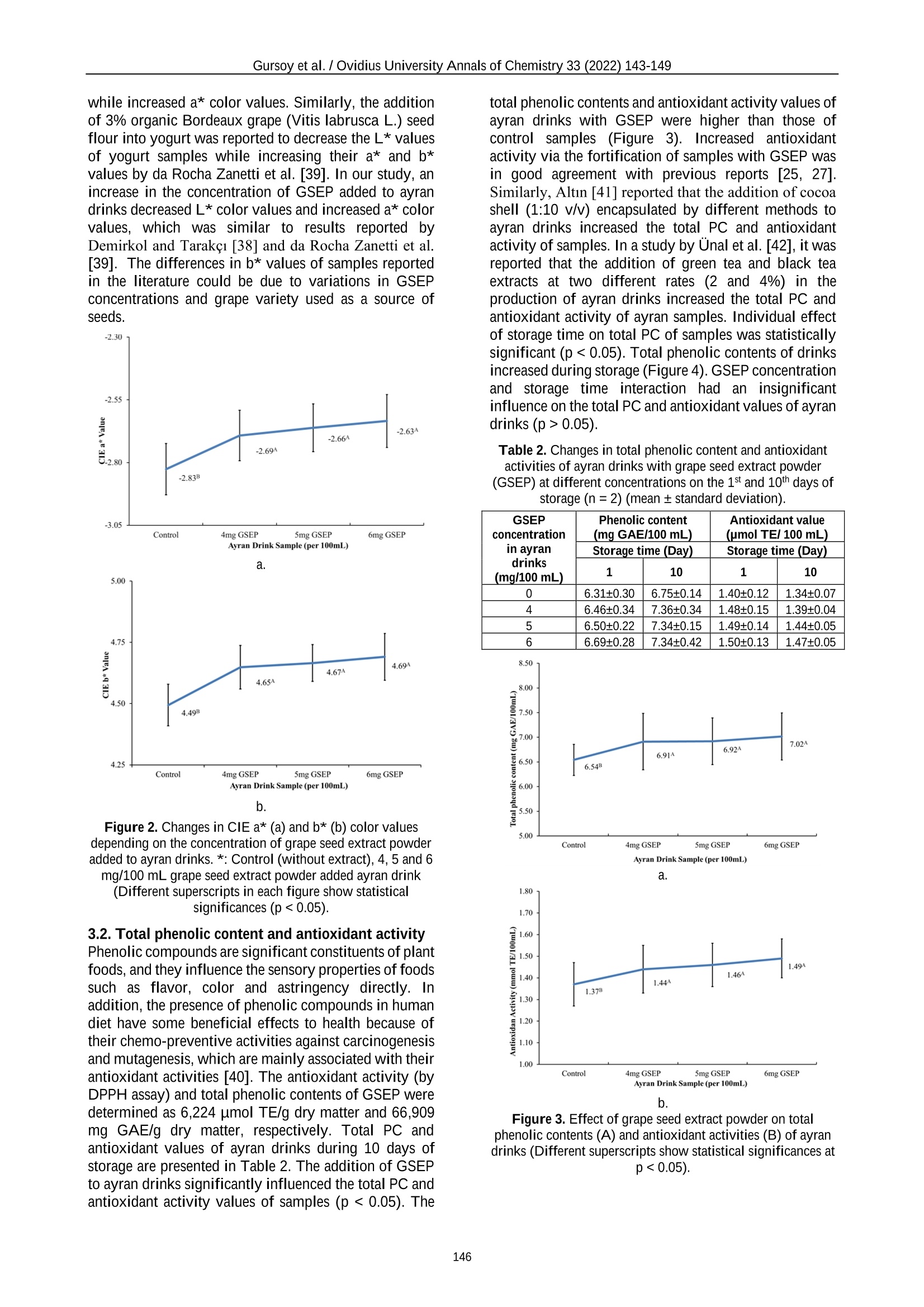
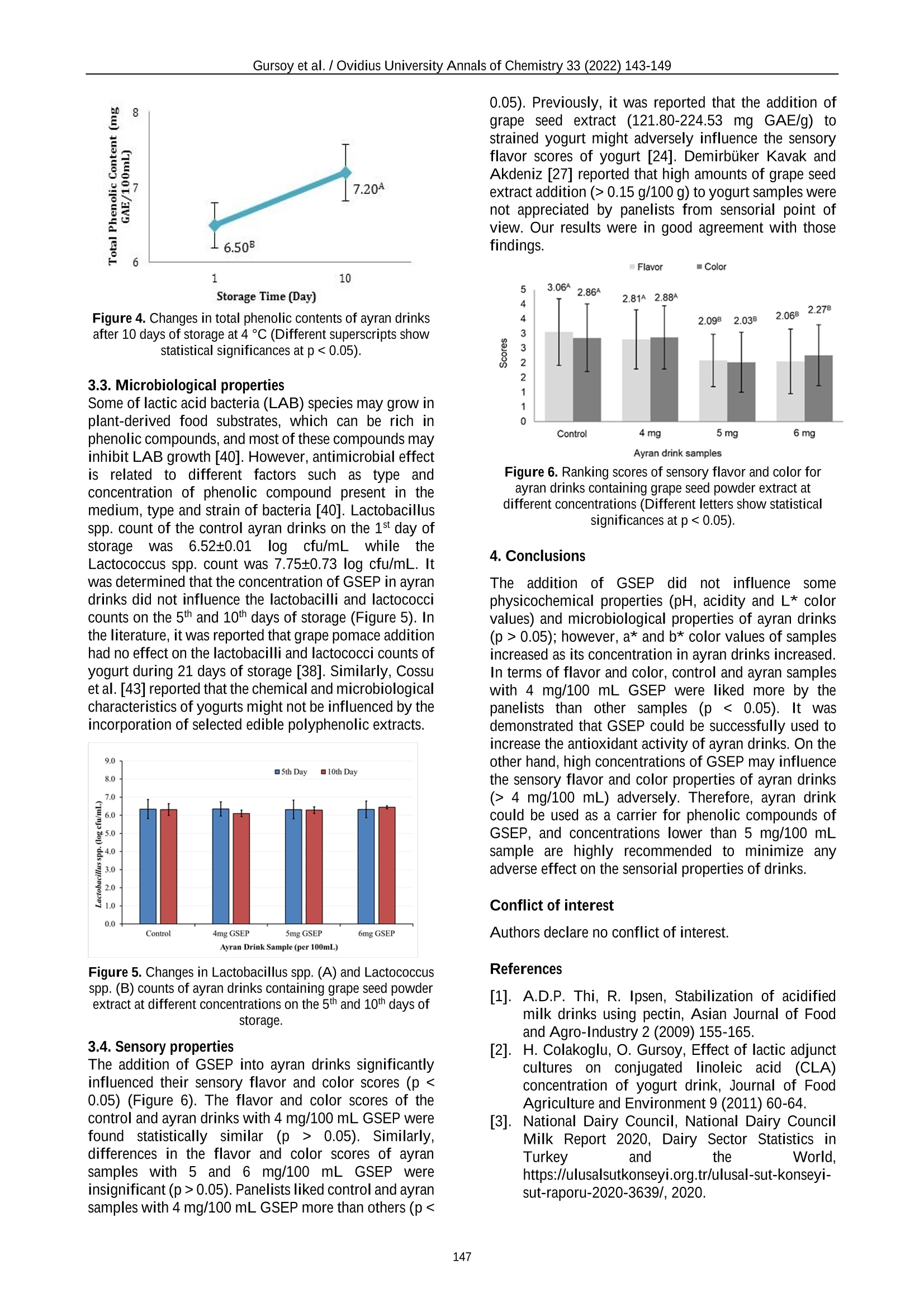
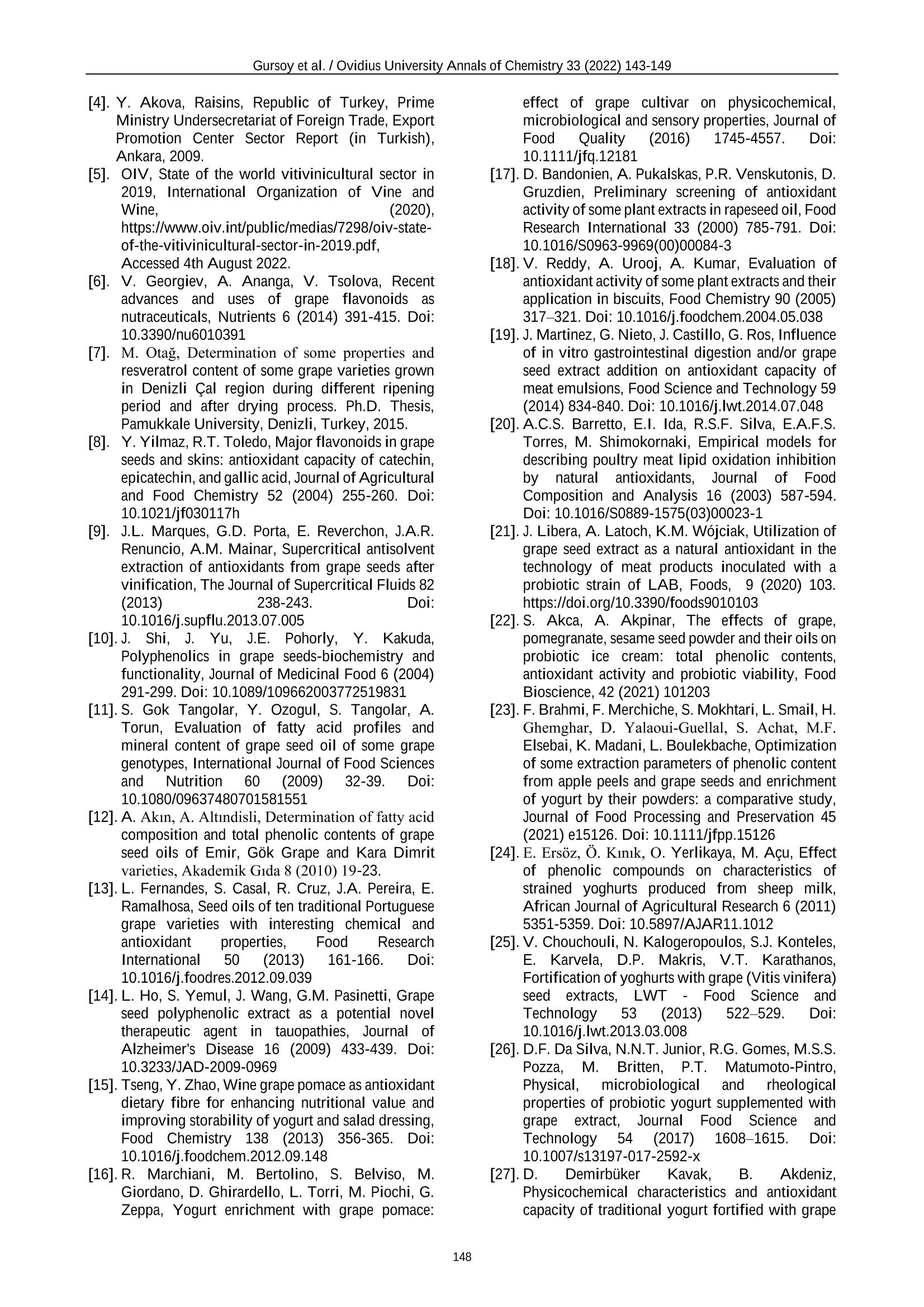

还剩5页未读,是否继续阅读?
中国格哈特为您提供《酸奶饮料中蛋白质含量的检测》,该方案主要用于液体乳中营养成分检测,参考标准--,《酸奶饮料中蛋白质含量的检测》用到的仪器有格哈特杜马斯定氮仪DT N Pro
推荐专场
相关方案
更多
该厂商其他方案
更多













